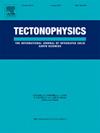Crustal fluids play an essential role in the activity of crustal earthquakes. The north Ibaraki area in northeastern Japan has shown intense crustal seismicity after the 2011 Tohoku-oki earthquake. In this area, it is discussed that crustal fluids are supplied from the deep part of the Earth's crust and contribute to the genesis of these crustal earthquakes. To investigate the distribution of crustal fluids in this area, we focused on reflected S-waves, which are highly sensitive to the presence of crustal fluids. We developed an approach based on the Markov chain Monte Carlo method to precisely and quantitatively estimate the location of the crustal reflector and its geometry. The obtained results showed that the crustal reflector was located at depths of 15–25 km and dipped shallowly to the northwest. The crustal reflector was positioned above the region characterized by low seismic wave velocity and electrical resistivity anomalies in the lower crust, suggesting that the crustal reflector is the uppermost boundary of a fluid-rich zone. The distribution of the fluid-rich zone closely corresponded to the cutoff depths of crustal earthquakes. This fluid-rich zone was likely the source of the fluid that enhanced seismicity in the shallow part of the crust in the target area. In contrast, the fluid-rich zone itself may have suppressed the genesis of crustal earthquakes. We hypothesized that hydrothermal fluids might affect the shallowing of these cutoff depths. If the hydrothermal fluid was contained in the fluid-rich zone, it could induce a shallow brittle-ductile transition by increasing the temperature of the surrounding rocks.


